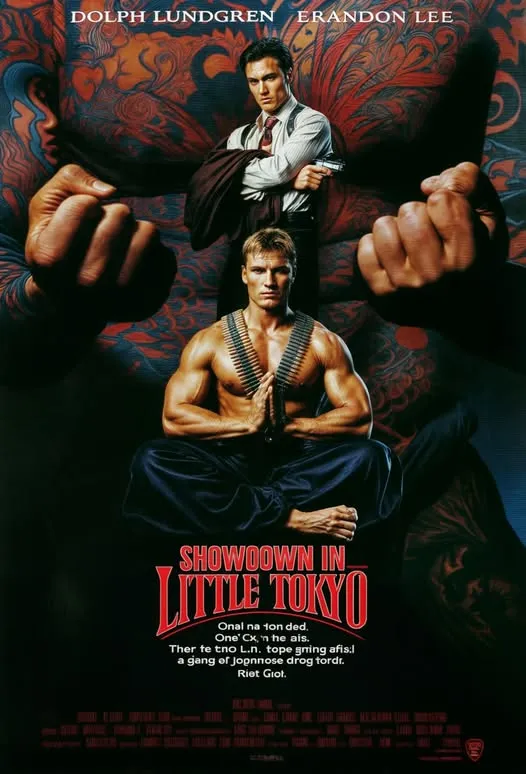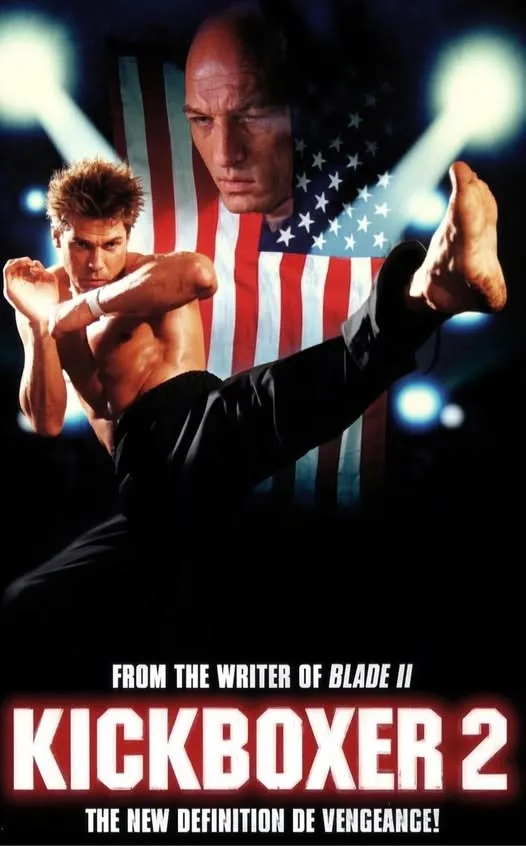Showdown in Little Tokyo (1991), directed by Mark L. Lester, is an action-packed film set in the vibrant Little Tokyo district of Los Angeles. The story revolves around two police officers—Chris Kenner, played by Dolph Lundgren, and Johnny Murata, portrayed by Brandon Lee—who team up to take down the notorious Yakuza, a Japanese criminal syndicate operating within the community. The film begins by introducing Kenner, a tough and stoic cop who has a deep personal connection to the Yakuza. As a child, Kenner’s parents were brutally murdered by the criminal organization, leaving him scarred and driven by a thirst for revenge. This traumatic event has shaped his personality, making him more violent and obsessed with justice. In contrast, Murata is a lighter, more easygoing cop of Japanese descent who grew up in Little Tokyo. He is deeply connected to the community and is more willing to approach situations with a sense of cultural understanding and wit. Though their personalities differ greatly, the two men are forced to work together when they find themselves assigned to investigate a series of violent crimes linked to the Yakuza. As the investigation unfolds, Kenner and Murata begin to uncover a massive network of illegal activities controlled by the Yakuza. These crimes include drug trafficking, extortion, and illegal smuggling operations. The film establishes the complex relationship between Kenner and Murata, who, despite their differences, complement each other as partners. Kenner’s intense drive for vengeance often clashes with Murata’s more calm and composed approach to law enforcement. However, Murata quickly becomes more than just a partner; he is a bridge between Kenner’s burning desire for retribution and his ability to maintain a sense of morality and justice. While Kenner is focused on the destruction of the Yakuza, Murata is intent on bringing the criminal syndicate down in a way that upholds the law and ensures that justice prevails. The dynamic between the two characters adds depth to the narrative, with each of them providing a different perspective on how to confront the dangerous world of organized crime.

The central antagonist of the film is Yoshida, the sadistic leader of the Yakuza who not only runs the criminal empire in Little Tokyo but also holds a personal grudge against Kenner. Yoshida’s brutal nature and his ability to manipulate those around him heighten the stakes of the investigation. As Kenner and Murata get closer to uncovering the truth, they encounter numerous obstacles—violent confrontations with Yakuza enforcers, shootouts, and challenges from within the police force itself. The film’s action sequences are fast-paced and intense, with Kenner and Murata frequently finding themselves in life-or-death situations. While Kenner relies on his physical strength and experience in combat, Murata’s skill in martial arts and his ability to think on his feet allow him to take on opponents in a more fluid and calculated manner. These contrasting fighting styles make for dynamic action sequences, with hand-to-hand combat, gunfights, and martial arts battles showcasing the characters’ strengths and weaknesses. One of the most compelling aspects of Showdown in Little Tokyo is the way it explores the personal vendettas and motivations of the main characters, particularly Kenner. Throughout the film, Kenner’s desire for revenge clouds his judgment, leading him to take reckless risks and act out of anger rather than reason. His obsession with avenging his parents’ deaths makes him more isolated, and he often acts without fully considering the consequences of his actions. This obsession is highlighted in several key scenes, including a tense moment when Kenner chooses to pursue Yoshida, knowing that it could put both himself and Murata in jeopardy. As the investigation progresses, Kenner’s increasing frustration and emotional turmoil add an emotional layer to the film, demonstrating how revenge can consume a person and lead them down a destructive path. In contrast, Murata serves as a stabilizing force for Kenner, reminding him that the ultimate goal is justice, not personal vengeance. Their relationship evolves from one of professional necessity to one of mutual respect and friendship as they navigate the dangers of their mission. The film reaches its climax during a final showdown between Kenner and Yoshida. After a series of violent confrontations, the two men face off in an explosive fight that pits Kenner’s physical strength against Yoshida’s sadistic intelligence. The final battle is a culmination of the emotional journey Kenner has undergone throughout the film. As he faces his childhood enemy, Kenner is forced to confront not only the man who killed his parents but also the darkness within himself that his obsession with vengeance has created. The stakes are high, with the fate of Little Tokyo and its residents hanging in the balance. The fight is brutal and intense, filled with dramatic moments that heighten the tension, culminating in a victory for Kenner. However, it is not simply the physical defeat of Yoshida that provides closure; it is the emotional resolution that comes with it. As Kenner takes down Yoshida and dismantles the Yakuza empire, he begins to understand that his pursuit of vengeance has taken a toll on his soul and that true justice is not about revenge, but about ensuring that the criminals are brought to justice and that the community is protected.

In the aftermath of the final battle, the film wraps up with a sense of closure for the characters and the story. The Yakuza organization is dismantled, and Little Tokyo begins to recover from the chaos it has endured. Kenner and Murata, now bonded by their experiences and their shared commitment to justice, share a quiet moment of camaraderie. Kenner, having faced his demons and taken down his enemy, is no longer consumed by his need for revenge. Murata, who has been a steady influence throughout the film, offers Kenner a sense of redemption and peace that he has long sought. The film ends on a hopeful note, showing that through friendship, loyalty, and a commitment to doing what is right, the two officers have brought justice to the community and, in a way, to themselves. Showdown in Little Tokyo is more than just an action film; it is a story about personal growth, friendship, and the emotional costs of revenge. The film explores themes of justice, morality, and the impact of past trauma on an individual’s psyche. With its explosive action sequences, strong performances from Lundgren and Lee, and emotional depth, Showdown in Little Tokyo stands as a memorable entry in the action genre, offering both thrilling spectacle and a poignant exploration of the human condition.



-1741744466-q80.webp)
-1739929188-q80.webp)